Classical Weimar: In the late 18th and early 19th centuries, the city of Weimar witnessed a remarkable cultural flowering. It was during the lifetime of Duchess Anna Amalia von Sachsen-Weimar-Eisenach (1739-1809) that the Classical Weimar Period began. Weimar attracted many poets, philosophers and writers, such as Goethe, Schiller and Herder. The Goethe and Schiller Archive in Weimar houses the Literary estate of Goethe, which was inscribed on the UNESCO Memory of the World Register. Weimar attracted also composers such as Franz Liszt. The artistic quality of public and private buildings and parks in and around Weimar testify to the cultural flowering of the Classical Weimar Period. Later, Weimar became a centre for the development of new movements in the fine arts and architecture. Besides the World Heritage Site Classical Weimar, there is another World Heritage in Weimar: the Bauhaus and its Sites in Weimar and Dessau. Weimar is situated in the eastern part of Germany, some 83 km from a UNESCO World Heritage Site in Eisenach. Classical Weimar was declared a UNESCO World Heritage in 1998.
www.werelderfgoedfotos.nl © Copyright World Heritage Photos
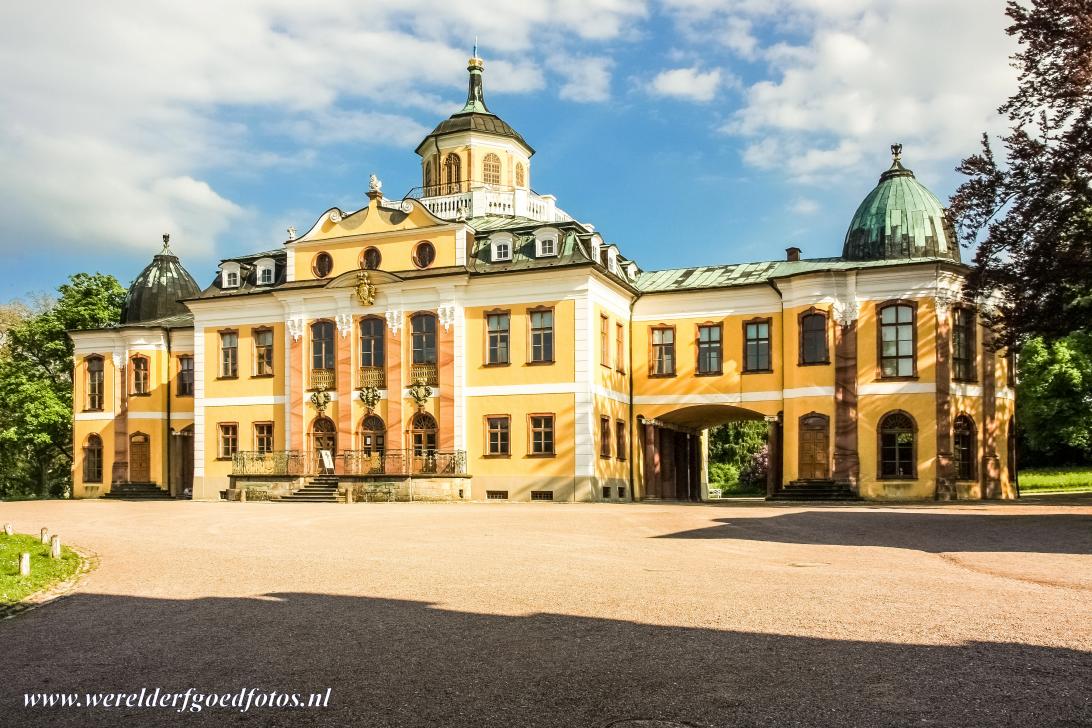
Classical Weimar: Belvedere Palace is located in Belvedere Palace Park just outside Weimar, the Baroque palace was the widow seat of Maria Pavlovna, she died here in 1859. Belvedere Palace and its orangery are regarded as the most important Baroque buildings in Weimar. The palace originally served as a hunting lodge, it is surrounded by stables and gardens. Today, Belvedere Palace is a museum. Belvedere Palace is part of the UNESCO World Heritage: Classical Weimar.

Classical Weimar: Belvedere Palace is located in Belvedere Palace Park just outside Weimar, the Baroque palace was the widow seat of Maria Pavlovna, she died here in 1859. Belvedere Palace and its orangery are regarded as the most important Baroque buildings in Weimar. The palace originally served as a hunting lodge, it is surrounded by stables and gardens. Today, Belvedere Palace is a museum. Belvedere Palace is part of the UNESCO World Heritage: Classical Weimar.
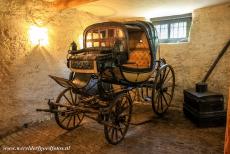
Classical Weimar: The horse carriage of Johann Wolfgang von Goethe at the Goethe House. He used this carriage only for short trips in and around the city of Weimar. Von Goethe lived in this house in Weimar from 1782 to 1789 and also from 1792 until his death in 1832. Von Goethe also owned a garden house in the Park an der Ilm in Weimar. Classical Weimar gained the status as a UNESCO World Heritage in 1998.
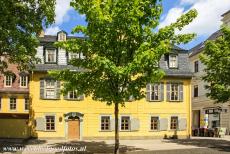
Classical Weimar: The Schiller House. The German classical playwright Friedrich Schiller lived in this house from 1802 until his death in 1805. One of the most interesting rooms is the study of Schiller, here he wrote his last play William Tell, most of the furniture is authentic. Schiller died at the age of 45, the Schiller Family lived in the house until the death of Schiller's wife Charlotte in 1826. The Schiller House was damaged during WWII, but was completely restored.
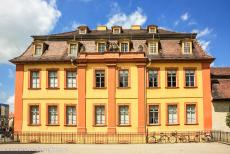
Classical Weimar: The Wittums Palace was built from 1767 to 1769, the Baroque palace was the widow's residence of Duchess Anna Amalia von Sachsen-Weimar-Eisenach, she lived in this town palace until her death in 1807. The palace is an example the aristocratic living style in Weimar at the end of the 18th century. The Green Parlour is the most authentic room. Just like the German National Theatre in Weimar, the Wittums Palace is situated on the Theaterplatz in Weimar.
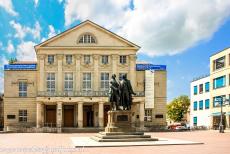
Classical Weimar: The Goethe and Schiller Monument in front of the Deutsches Nationaltheater, the National Theatre of Germany. Goethe and Schiller have lived in Weimar and were the most influential figures of the literary movement Weimar Classicism. The monument escaped damage from Allied bombing in 1942, the National Theatre was totally destroyed, but was reconstructed and reopened in 1948 with the performance of the most famous work of Goethe: Faust.
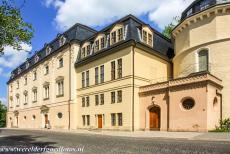
Classical Weimar: Duchess Anna Amalia von Sachsen-Weimar-Eisenach had the 16the century Green Palace rebuilt to house a library. The library is one of the first ducal libraries in Germany to be made accessible to the public. The Duchess Anna Amalia Library houses over one million volumes from the 9th to the 21th centuries. A part of the collection was destroyed or damaged by fire in 2004, a large part of the collection was saved, among them the Luther Bible of 1534.
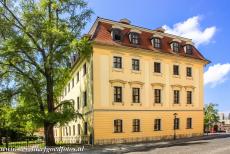
Classical Weimar: The Prince's House and Weimar's oldest Ginkgo biloba tree, probably planted in 1813. The Ginkgo was the favourite tree of Johann Wolfgang von Goethe, he was intriuged by the tree, especially in the fan-shaped leaves, he was inspired by the Ginkgo and wrote the poem 'Ginkgo biloba'. Goethe is considered the most important German literary figure of the modern era. Classical Weimar was inscribed on the UNESCO World Heritage List in 1998.
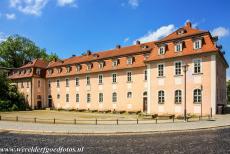
Classical Weimar: The House of Charlotte von Stein. Charlotte von Stein was a close friend to the poet, novelist and playwright Johann Wolfgang von Goethe, his life and early work were strongly influenced by her, she also was a close friend to the philosopher, poet and playwright Friedrich Schiller. These two great German writers have lived in Weimar and had a remarkable friendship. Goethe and Schiller are closely linked to the German city of Weimar.
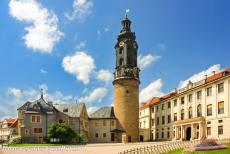
Classical Weimar: The Town Palace and the tower of the palace. The Town Palace is the former Ducal Court of Weimar. The composer J.S. Bach was the organist and concertmaster at the Ducal Court. The Ducal Court encouraged Martin Luther, who visited Weimar several times. The Town Palace is now a museum, it houses the Cranach gallery, art of renowned Old Dutch masters and also four writer's rooms, dedicated to Goethe, Schiller, Herder and Wieland.
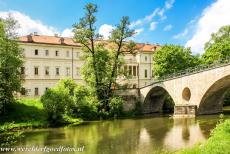
Classical Weimar: The Sternbrücke, also Schlossbrücke, and the Ducal Town Palace viewed from the Park an der Ilm. The Sternbrücke (Star Bridge) is the oldest bridge in Weimar. The stone arch bridge was built over the river Ilm in the 17th century. The Town Palace is situated on the banks of the River Ilm, the palace was damaged by a fire in 1774, the restoration took many years. The Park an der Ilm stretches along the banks of the Ilm. It belongs to the World Heritage in Weimar.
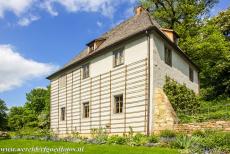
Classical Weimar: Goethe's Garden House in the Park an der Ilm. Johann Wolfgang von Goethe lived in this garden house until 1782, afterwards he only returned here to work and rest. Goethe owned also a house at the Frauenplan in Weimar. Goethe's Garden House was already openend as a museum in 1886, it is situated nearby the Haus am Horn, the first practical statement of the Bauhaus in Weimar, also a UNESCO World Heritage.
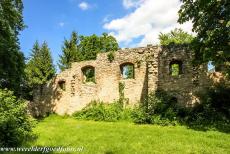
Classical Weimar: A romantic ruin, one of the follies in the Park an der Ilm. The park was created in the 18th century, influenced by Goethe. The English landscape park is located on the banks of the river Ilm. The park is decorated with follies, statues, bridges and planted with valuable trees. The most renowned buildings in the Park an der Ilm are Goethe's Garden House and the Roman House, inspired by the Italian villas surrounding Rome.
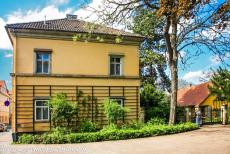
Classical Weimar: The 18th century Liszt House is nowadays a museum, the study of the famous Hungarian composer is preserved. Franz Liszt lived in Weimar from 1869 until his death in 1886, he also spent some months every year in Rome and Budapest. The composer J.S. Bach lived in Weimar from 1708 until 1717. The house where Bach lived has disappeared, the location of the house was on the Market Square in Weimar. The site is indicated with a commemorative tablet.
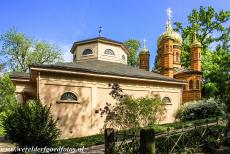
Classical Weimar: The Russian Orthodox chapel and the Ducal Vault (on the left hand side). The Russian Orthodox chapel is a mausoleum, connected through an underground passage with the Ducal Vault, the Fürstengruft of Weimar. The Ducal Vault is the burial chapel of the ducal family of Sachsen-Weimar-Eisenach. The Ducal Vault is also the last resting place of Goethe. The Ducal Vault of Weimar houses also the coffin of Schiller, but the coffin of Schiller is empty.
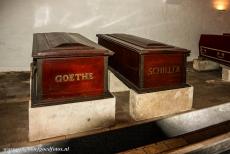
Classical Weimar: The Ducal Vault is the last resting place of Goethe. The Ducal Vault was built in the Historic Cemetery of Weimar in the period 1823-1828. The Ducal Vault also houses the coffin of Schiller. Today, the coffin of Schiller is empty. DNA testing of the remains in the coffin proved they were not Schiller's. The mortal remains of the philosopher, playwright and poet Friedrich Schiller are probably buried in a nameless grave somewhere in the Jacobs Cemetery in Weimar.

Classical Weimar: The Russian Orthodox chapel stands in the historical cemetery of Weimar. The Russian Orthodox chapel was built on Russian earth in 1860 -1862. The Russian tsar's daughter Grand Duchess Maria Pavlovna found her last resting place in the burial vault of the chapel. The onion dome is a typical feature of the Russian church architecture, the onion shape is similar to a candle flame and symbolizes the flame of faith reaching up to heaven.
